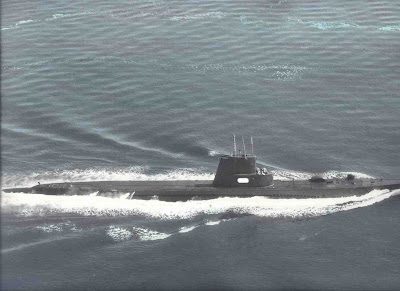Crush Depth

That February morning under the sea in 1967 began just like any other for the handsome 20-year-old submariner. He was a quartermaster (navigations) on a old-style conventional submarine somewhere in the
His shift ended, so he joined his mates in the tiny dining hall to play five-card stud. An appropriate game for men in uniform. They did not know, as the game progressed, that the on duty crew received instructions from the Captain to test the boats handling stability in reverse direction.
Initially they did not feel forward or backward movement at the slower speed, so they dealt their cards, unaware that the officer of the deck had ordered an all back 1/3 speed. The boat was moving with ease and maintaining a constant depth. The sailor reviewed his cards and discarded two.
Although huge diesel engines propel a submarine on the surface, it relies on electric motors powered by batteries while submerged. Two sailors with hand wheels independently control the bow and the stern plane systems, which regulate depth changes. One is responsible for small adjustments and the other for major changes. When the boat was traveling in reverse, the two sailor’s jobs also reversed. The small plane adjuster would now take on the job of major plane control.
When the crew responded to an all-back two-thirds order, they were barely able to maintain a level plane. The stern, now acting as the bow in the submarine’s reverse direction, was dropping slowly. The card game came to a halt as they sensed the cavitations from the changed rotation of the propellers.
He doesn’t know how it happened. There may have been a miscommunication. Perhaps an order given or misunderstood. In any event, the boat went to an all-back full even though problems were already manifesting.
The situation turned ominous as the stern began to nose-dive rapidly.
The table tilted and the men and cards slid with it. A pitcher of milk fell from a kitchen counter and hit the dining room wall without touching the floor. All four men braced against the wall, fear evident in their faces but not overruling their thoughts.
In order to qualify in submarines, a sailor must demonstrate knowledge in all systems: electrical, torpedo, engine, damage control, etc. The well-trained young and seasoned submariners mentally began to rehearse the emergency scenarios and responses.
There was an immediate order to blow the ballast tanks, which forces all the water out around the hull providing positive buoyancy. The plunge continued.
The Captain then ordered an emergency blow of the negative tanks for maximum ballast.
The weakest part of a conventional sub is where the drive shaft passes through the stern to the propellers. If the boat reached a certain (classified at the time) depth, the projection was failure (crush) in the packing around the shaft.
The young sailor was keenly aware of the popping and creaking metal of the hull. When this uncontrolled descent halted, (it was later calculated that) the lowest end of the acutely angled boat was 125 feet below test depth.
Then the boat began to rise. It picked up speed as it headed for the surface. The momentum of the massive steel monster popped it far enough out of the water that when it settled back his stomach dropped like it does on the first dip of a roller coaster.
Not all of the crew were aware of the potential risk they had encountered until after surfacing.
There were incident reports to file, and other possible ramifications to the officers in charge. Fortunately, there were neither injuries to the men nor any known structural damage to the boat.
The most important information of all: The future of my children and grandchildren was secure -- still twinkling in the eyes of a handsome sailor.


Comments
Was he your husband's father?
Thank you for sharing this piece of history with us, Pamela!
My husband.
I look forward to reading more!! :D
He is fascinated with submarine history. Thankfully this incident did not end like the Thresher.
xo
So great!
Glad it had a happy ending!
Hugs,
Sue
what a way with words!!